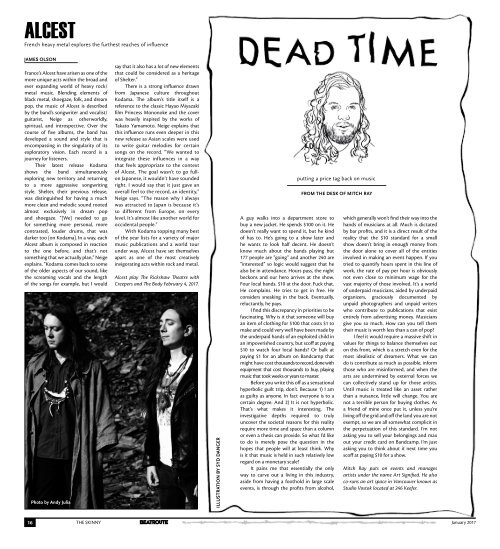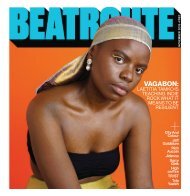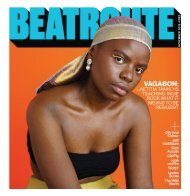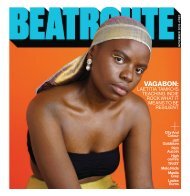BeatRoute Magazine B.C. print e-edition - January 2017
BeatRoute Magazine is a monthly arts and entertainment paper with a predominant focus on music – local, independent or otherwise. The paper started in June 2004 and continues to provide a healthy dose of perversity while exercising rock ‘n’ roll ethics.
BeatRoute Magazine is a monthly arts and entertainment paper with a predominant focus on music – local, independent or otherwise. The paper started in June 2004 and continues to provide a healthy dose of perversity while exercising rock ‘n’ roll ethics.
Create successful ePaper yourself
Turn your PDF publications into a flip-book with our unique Google optimized e-Paper software.
ALCEST<br />
French heavy metal explores the furthest reaches of influence<br />
James Olson<br />
France’s Alcest have arisen as one of the<br />
more unique acts within the broad and<br />
ever expanding world of heavy rock/<br />
metal music. Blending elements of<br />
black metal, shoegaze, folk, and dream<br />
pop, the music of Alcest is described<br />
by the band’s songwriter and vocalist/<br />
guitarist, Neige as otherworldly,<br />
spiritual, and introspective. Over the<br />
course of five albums, the band has<br />
developed a sound and style that is<br />
encompassing in the singularity of its<br />
exploratory vision. Each record is a<br />
journey for listeners.<br />
Their latest release Kodama<br />
shows the band simultaneously<br />
exploring new territory and returning<br />
to a more aggressive songwriting<br />
style. Shelter, their previous release,<br />
was distinguished for having a much<br />
more clean and melodic sound rooted<br />
almost exclusively in dream pop<br />
and shoegaze. “[We] needed to go<br />
for something more personal, more<br />
contrasted, louder drums, that was<br />
darker too [on Kodama]. In a way, each<br />
Alcest album is composed in reaction<br />
to the one before, and that’s not<br />
something that we actually plan,” Neige<br />
explains. “Kodama comes back to some<br />
of the older aspects of our sound, like<br />
the screaming vocals and the length<br />
of the songs for example, but I would<br />
Photo by Andy Julia<br />
say that it also has a lot of new elements<br />
that could be considered as a heritage<br />
of Shelter.”<br />
There is a strong influence drawn<br />
from Japanese culture throughout<br />
Kodama. The album’s title itself is a<br />
reference to the classic Hayao Miyazaki<br />
film Princess Mononoke and the cover<br />
was heavily inspired by the works of<br />
Takato Yamamoto. Neige explains that<br />
this influence runs even deeper in this<br />
new release as Asian scales were used<br />
to write guitar melodies for certain<br />
songs on the record. “We wanted to<br />
integrate these influences in a way<br />
that feels appropriate to the context<br />
of Alcest. The goal wasn’t to go fullon<br />
Japanese, it wouldn’t have sounded<br />
right. I would say that it just gave an<br />
overall feel to the record, an identity,”<br />
Neige says. “The reason why I always<br />
was attracted to Japan is because it’s<br />
so different from Europe, on every<br />
level. It’s almost like another world for<br />
occidental people.”<br />
With Kodama topping many best<br />
of the year lists for a variety of major<br />
music publications and a world tour<br />
under way, Alcest have set themselves<br />
apart as one of the most creatively<br />
invigorating acts within rock and metal.<br />
Alcest play The Rickshaw Theatre with<br />
Creepers and The Body February 4, <strong>2017</strong>.<br />
illustration by syd danger<br />
A guy walks into a department store to<br />
buy a new jacket. He spends $100 on it. He<br />
doesn’t really want to spend it, but he kind<br />
of has to. He’s going to a show later and<br />
he wants to look half decent. He doesn’t<br />
know much about the bands playing but<br />
177 people are “going” and another 240 are<br />
“interested” so logic would suggest that he<br />
also be in attendance. Hours pass, the night<br />
beckons and our hero arrives at the show.<br />
Four local bands. $10 at the door. Fuck that.<br />
He complains. He tries to get in free. He<br />
considers sneaking in the back. Eventually,<br />
reluctantly, he pays.<br />
I find this discrepancy in priorities to be<br />
fascinating. Why is it that someone will buy<br />
an item of clothing for $100 that costs $1 to<br />
make and could very well have been made by<br />
the underpaid hands of an exploited child in<br />
an impoverished country, but scoff at paying<br />
$10 to watch four local bands? Or balk at<br />
paying $1 for an album on Bandcamp that<br />
might have cost thousands to record, done with<br />
equipment that cost thousands to buy, playing<br />
music that took weeks or years to master.<br />
Before you write this off as a sensational<br />
hyperbolic guilt trip, don’t. Because 1) I am<br />
as guilty as anyone. In fact everyone is to a<br />
certain degree. And 2) It is not hyperbolic.<br />
That’s what makes it interesting. The<br />
investigative depths required to truly<br />
uncover the societal reasons for this reality<br />
require more time and space than a column<br />
or even a thesis can provide. So what I’d like<br />
to do is merely pose the question in the<br />
hopes that people will at least think. Why<br />
is it that music is held in such relatively low<br />
regard on a monetary scale?<br />
It pains me that essentially the only<br />
way to carve out a living in this industry,<br />
aside from having a foothold in large scale<br />
events, is through the profits from alcohol,<br />
putting a price tag back on music<br />
From the desk of Mitch Ray<br />
which generally won’t find their way into the<br />
hands of musicians at all. Much is dictated<br />
by bar profits, and it is a direct result of the<br />
reality that the $10 standard for a small<br />
show doesn’t bring in enough money from<br />
the door alone to cover all of the entities<br />
involved in making an event happen. If you<br />
tried to quantify hours spent in this line of<br />
work, the rate of pay per hour is obviously<br />
not even close to minimum wage for the<br />
vast majority of those involved. It’s a world<br />
of underpaid musicians, aided by underpaid<br />
organizers, graciously documented by<br />
unpaid photographers and unpaid writers<br />
who contribute to publications that exist<br />
entirely from advertising money. Musicians<br />
give you so much. How can you tell them<br />
their music is worth less than a can of pop?<br />
I feel it would require a massive shift in<br />
values for things to balance themselves out<br />
on this front, which is a stretch even for the<br />
most idealistic of dreamers. What we can<br />
do is contribute as much as possible, inform<br />
those who are misinformed, and when the<br />
arts are undermined by external forces we<br />
can collectively stand up for those artists.<br />
Until music is treated like an asset rather<br />
than a nuisance, little will change. You are<br />
not a terrible person for buying clothes. As<br />
a friend of mine once put it, unless you’re<br />
living off the grid and off the land you are not<br />
exempt, so we are all somewhat complicit in<br />
the perpetuation of this standard. I’m not<br />
asking you to sell your belongings and max<br />
out your credit card on Bandcamp, I’m just<br />
asking you to think about it next time you<br />
scoff at paying $10 for a show.<br />
Mitch Ray puts on events and manages<br />
artists under the name Art Signified. He also<br />
co-runs an art space in Vancouver known as<br />
Studio Vostok located at 246 Keefer.<br />
16 The skinny<br />
<strong>January</strong> <strong>2017</strong>


















